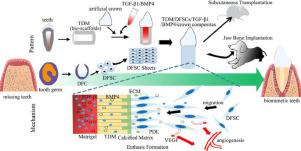Applied Materials Today ( IF 7.2 ) Pub Date : 2020-07-08 , DOI: 10.1016/j.apmt.2020.100742 Jie Chen , Lijun Liao , Tingting Lan , Zhijun Zhang , Kuo Gai , Yibing Huang , Jinlong Chen , Weidong Tian , Weihua Guo

|
Biomaterial scaffold-based bioengineered tooth root (bio-root) has been proven to be a prospective tool for the treatment of tooth loss. However, while emulating the mechanical integrity of native tooth root, the regenerated bio-root still has limited capacity to achieve long-term functional stability because of lacking the effective cervical seal. Enlightened by physiological cues from cervical seal development and recovery of native tooth, this study reports a bioinspired approach as incorporation of two pivotal odontogenic growth factors (TGF-β1 and BMP4) into biomaterial scaffold (treated dentin matrix, TDM) embodying a spatial interface gradient for functional enthesis formation to promote functional bio-root regeneration. The biological characteristics of dental follicle stem cells (DFSCs) induced by TGF-β1/BMP4 were studied by relevant gene and protein expressions in vitro as well as ectopic subcutaneous transplantation and orthotopic jaw bone implantation in vivo. We further fabricated artificial crown-TDM/TGF-β1/BMP4/DFSCs in beagle to verify the potential occlusional function of regenerated bio-root. Notably, TGF-β1/BMP4 synergistically activated proliferation, migration and osteoinductivity related to the enthesis differentiation of DFSCs as increasing expressions of Periostin, BSP, OPN, ALP, Vinculin, and Paxillin and ascending numbers of migrated cells. The TDM/TGF-β1/BMP4/DFSCs composites imparted the uniform and persistent inductive interface for neovascularization and canonical enthesis regeneration. During more than 5 months follow-up in beagle model, the effectively functional bio-roots were distinguished by outstanding biomechanical properties and healthy gingiva similar to native teeth. This notion of integrating TGF-β1/BMP4 with TDM and DFSCs provides an alternative strategy for biomimetic bio-root regeneration and other interface tissue engineering.
中文翻译:

经过处理的带有TGF-β1/ BMP4的基于牙本质基质的支架可用于功能性生物根再生
基于生物材料支架的生物工程牙根(bio-root)已被证明是治疗牙齿脱落的前瞻性工具。然而,尽管模拟天然牙根的机械完整性,但由于缺乏有效的颈椎密封,再生的生物根仍然无法获得长期的功能稳定性。受到宫颈密封发育和天然牙齿恢复的生理学提示的启发,该研究报告了一种生物启发的方法,即将两个关键牙源性生长因子(TGF-β1和BMP4)掺入体现空间界面梯度的生物材料支架(处理过的牙本质基质,TDM)中用于功能性实体形成,以促进功能性生物根再生。通过体外相关基因和蛋白质表达以及异位皮下移植和原位颌骨植入研究了TGF-β1/ BMP4诱导的牙囊干细胞(DFSCs)的生物学特性。我们进一步在比格犬中制造了人工冠状TDM /TGF-β1/ BMP4 / DFSC,以验证再生生物根的潜在咬合功能。值得注意的是,随着Periostin,BSP,OPN,ALP,Vinculin和Paxillin的表达增加以及迁移的细胞数量增加,TGF-β1/ BMP4协同激活了DFSCs的分化分化相关的增殖,迁移和骨诱导性。TDM /TGF-β1/ BMP4 / DFSCs复合材料为新血管形成和规范的新陈代谢提供了统一而持久的诱导界面。在对比格犬模型进行的5个月以上的随访中,具有有效功能的生物根系具有出色的生物力学特性和类似于天然牙齿的健康牙龈。将TGF-β1/ BMP4与TDM和DFSC整合在一起的想法为仿生生物根再生和其他界面组织工程提供了另一种策略。











































 京公网安备 11010802027423号
京公网安备 11010802027423号